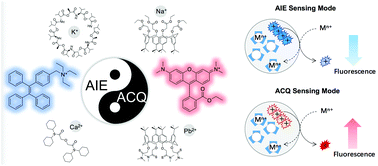Ionophores have been integrated into various electrochemical and optical sensing platforms for the selective detection of ions. Previous ionophore-based optical sensors rely on a H+ chromoionophore as the signal transducer and consequently, suffered from a pH cross-response. pH independent methods were proposed very recently by utilizing the solvatochromic dyes or the exhaustive mode. Here, we report a pH independent sensing principle based on nanospheres containing ionophores. As the ion-exchange occurs, the signal transducer undergoes aggregation-induced emission (AIE) or aggregation-caused quenching (ACQ), leading to a dramatic change in fluorescence intensity. The principle was evaluated on different ionophores including those selective for K+, Na+, Ca2+, and Pb2+. The nanospheres were also introduced into microfluidic chips and successfully applied for the determination of sodium and potassium ion concentrations in diluted blood serum and urine samples.
